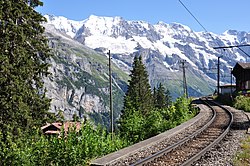|
Lauterbrunnen–Mürren Mountain Railway
The Lauterbrunnen–Mürren Mountain Railway (German: Bergbahn Lauterbrunnen–Mürren, BLM, also known as Mürrenbahn) is a hybrid transport system in the Bernese Oberland area of Switzerland, which connects the villages of Lauterbrunnen and Mürren. The system consists of a connected aerial cableway, also known as the Grütschalpbahn, and an adhesion worked mountain railway. The cableway replaced a funicular, on the same route, in 2010.[1][2][3] The line provides a vital passenger and goods link to the resort village of Mürren, which is situated above the cliffs of the Lauterbrunnen Valley and has poor road access. It also commands a view of the Eiger, Mönch and Jungfrau mountains across the depths of that valley.[2][4] The line is owned by the Bergbahn Lauterbrunnen-Mürren AG, a subsidiary of the Jungfraubahn Holding AG, a holding company that also owns the Wengernalpbahn, Jungfraubahn, Harderbahn, and Firstbahn.[5] Through that holding company it is part of the Allianz - Jungfrau Top of Europe marketing alliance, which also includes the separately owned Berner Oberland-Bahn and Schynige Platte-Bahn.[1][6] History The key milestones in the history of the line are:[citation needed] 
OperationRoute The BLM commences from Lauterbrunnen, using a terminus that is directly opposite the platforms of the Berner Oberland-Bahn (BOB) to Interlaken, and the Wengernalpbahn (WAB) to Kleine Scheidegg and Grindelwald. The first section of the line is an aerial cableway that rises 690 m (2,263.8 ft) in a distance of 1.4 km (0.9 mi). The cableway follows the line of the funicular that preceded it, and the remains of the funicular are visible at many points.[2][8]  The aerial cableway and railway connect at Grütschalp station, where both lines are within a single building, which also contains the line's workshop. A complex transfer machine in the station is used to transfer goods between the two sections and is well used since road access to Mürren is virtually impossible. The same machine was used to transfer goods between the funicular and rail, and has been retained for use with the cable car.[8][2][4] From Grütschalp to Mürren the line is continued as a 4.27 km (2.7 mi) long narrow gauge electric railway, which rises 152 m (498.7 ft). Through most of its length, the rail line commands a view of the Eiger, Mönch and Jungfrau across the depths of the Lauterbrunnen Valley. The railway has a single intermediate calling point, at Winteregg station, and runs to a terminus at Mürren station, where the platforms used by passengers are enclosed within a modern station building. Just before the station is reached, the line passes a large freight depot, used in the carriage of freight to Mürren.[2][4] Cable car The cable car section of the line is operated by a single cable car, which shuttles between Lauterbrunnen and Grütschalp with a journey time of 4 minutes. The car has an upper passenger level, carrying up to 100 passengers, and a lower level capable of carrying 6 tonnes of freight. The cable car is scheduled with the railway to provide a through journey frequency of between two and four services per hour.[7][9] Rail infrastructure The rail line is single-track, with a passing loop at Winteregg station. It has a track gauge of 1,000 mm (3 ft 3+3⁄8 in) and is electrified at 550 V DC supplied by overhead line. The line is operated using rail adhesion only, and has a maximum gradient of 5%. The former funicular shared the same track gauge, enabling the use of the funicular to transfer rolling stock to and from the electric railway.[2][4][8] The rail section is operated by single electric railcars, often towing or pushing a flat car for goods, with a journey time of 14 minutes. The railway is scheduled with the cable car to provide a through journey frequency of between two and four services per hour.[7][9] Rail vehiclesThe rail line uses the following self-propelled vehicles:[10]
In addition there are four low-floor flat cars, which are pushed or pulled by the passenger cars and carry demountable bodies that can be transferred to the cable car, and a number of unpowered works vehicles.[10] Recent developmentsIn order to meet legislative requirement for disabled access, the current fleet of trains have been replaced with modern low-floor vehicles. In September 2019 it was announced that Jungfraubahn Holding AG had awarded Stadler Rail at Bussnang a contract to supply three trainsets for at a cost of 17.3m Swiss francs. In addition, Mürren railway station, other stations and the Grütschalp workshop will be modernised.[11][12] The first car of the three trainsets was delivered in November 2023, and the second on 13 May 2024.[13] See alsoReferences
External links
|
||||||||||||||||||||||||||||||||||||||||||||||||||||||||||||||||||||||||||||||||||||||||||||||||||||||||||||||||||||||||||||||||||||||||||||||




